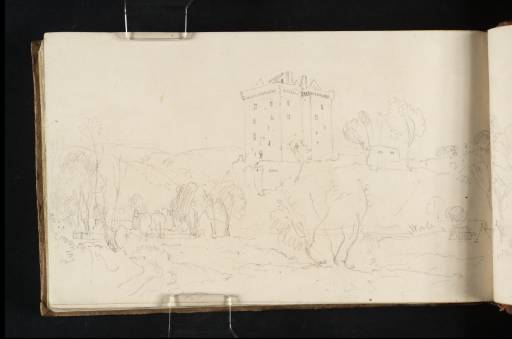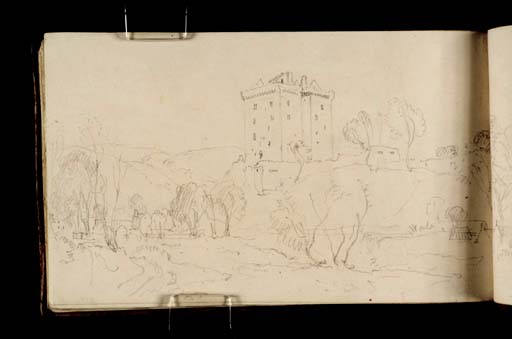Joseph Mallord William Turner Borthwick Castle 1818
Image 1 of 2
Joseph Mallord William Turner,
Borthwick Castle
1818
Joseph Mallord William Turner 1775–1851
Folio 83 Verso:
Borthwick Castle 1818
D13723
Turner Bequest CLXVII 75a
Turner Bequest CLXVII 75a
Pencil on white wove paper, 112 x 186 mm
Inscribed in pencil by Turner ‘wall’ lower right
Inscribed in pencil by Turner ‘wall’ lower right
Accepted by the nation as part of the Turner Bequest 1856
References
1909
A.J. Finberg, A Complete Inventory of the Drawings of the Turner Bequest, London 1909, vol.I, p.487, CLXVII 75a, as ‘Borthwick Castle.’.
1990
Eric Shanes, Turner’s Human Landscape, London 1990, pp.11, 13 illustrated, 247 note 3.
2000
Eric Shanes, Evelyn Joll, Ian Warrell and others, Turner: The Great Watercolours, exhibition catalogue, Royal Academy of Arts, London 2000, p.112.
This is one of two sketches of Borthwick Castle in this sketchbook (see folio 84; D13724; CLXVII 76) upon which Turner based his watercolour design for the first number of the Provincial Antiquities: Borthwick Castle, 1818 (Indianapolis Museum of Art).1 The castle is shown from the west north-west across the River Gore. At its north side, at the left of the picture, are two small cottages which still stand today, and at the right another cottage (no longer existing) in front of a low ‘wall’ which is also seen in the watercolour. The remaining round tower at the south corner of the curtain wall is shown at the right of the castle behind trees, and more trees are dotted around in the foreground. Behind the castle are the Lammermuir Hills.
Turner combined the two sketches in a study for Borthwick Castle which he made in the Scotland and London sketchbook, which was used back in the studio for some of his Provincial Antiquities designs (Tate D13815; Turner Bequest CLXX 2). While the final design shows the castle as if from the north-west, as in folio 84, the placement of the castle in the composition is closer to the present sketch as described above. The final design crops the composition slightly at the right and extends it at the left, and takes various trees from each sketch, all of which bend under a heavy gale, the significance of which is discussed by Shanes.2
Turner made about a dozen sketches of Borthwick in 1818, recording the appearance of the castle from each direction in this sketchbook (folios 83–85 verso; D13722, D13725, D13726 and D13727; CLXVII 75, 76a, 77, 77a) and the Edinburgh, 1818 sketchbook (Tate D13503, D13501 and D13551; Turner Bequest CLXVI 28, 28a and 52). Of these, folios 83 verso and 84 are the most finished drawings, suggesting that Turner already had a good idea of what he was after when he stood in front of the motif. He did, however, test out another viewpoint when he was preparing the design, working up the bottom sketch of folio 84 verso (D13725; CLXVII 76a) as a drawing in the Scotland and London sketchbook (Tate D13815; Turner Bequest CLXX 1). By January 1819 just a month or so after returning from Scotland Turner had completed his watercolour and submitted it to Henry Le Keux for engraving (Tate T04489).3
Thomas Ardill
April 2008
How to cite
Thomas Ardill, ‘Borthwick Castle 1818 by Joseph Mallord William Turner’, catalogue entry, April 2008, in David Blayney Brown (ed.), J.M.W. Turner: Sketchbooks, Drawings and Watercolours, Tate Research Publication, December 2012, https://www


